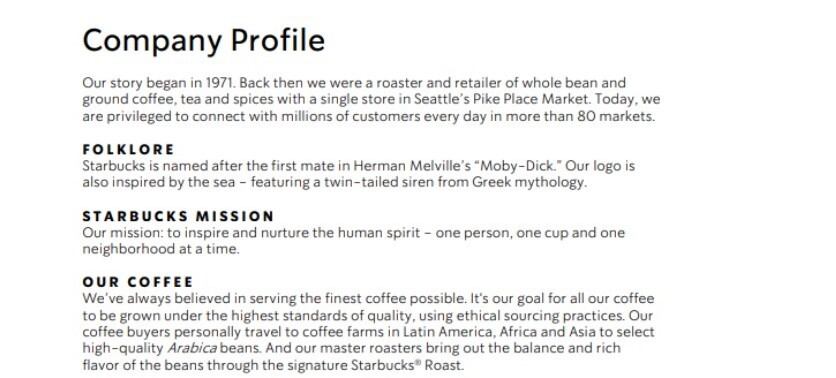Whether you own a small startup or a global conglomerate, having a company profile is a must. However, what you consider interesting could be an utter snooze fest for the reader, making you miss the chance to market your brand successfully.
If you want to ensure that you’ve got all the correct information to entice your reader, you need to turn the traditional business profile on its head and consider what your audience wants to know about your company.
To help you do that, we’ve outlined the most critical steps you need to follow to create a captivating company profile.
Watch our video which explains how to write a company profile:
Steps to writing a company profile
Step 1: Identify the profile’s purpose
Businesses use company profiles for different scenarios, including company websites, trade portfolios and investment plans. So, before you even put pen to paper, it’s vital to identify the profile’s purpose. Don’t worry - you can adapt it at a later stage if needed!
Let’s say your profile is meant to go on your business website. Create a list of points your readers would want to read about regarding your business and create a structure for your content. You should also make sure that the content’s tone matches your target audience. For instance, you don’t want to make it sound stuffy by bombarding a timeline of facts because – quite frankly – no one will care (other than yourself, of course)!
Step 2: Decide on a style
Now that you’ve established what kind of tone you should set for your profile, it’s time to identify how you will present this information. Do you want a typical style broken down by different sections, or do you want it presented in the form of a timeline? Some companies even choose to tell their story through a more visual approach, like Philips.
That said, you shouldn’t be afraid of being different and swaying away from the norm, as long as it is compatible with your brand and industry. For example, if you’re an accounting firm, it would probably be best to stick to the traditional format, including details of recent awards and achievements.
Step 3: Tell a story
When you’re trying to encourage people to pay attention to your business, you need to create a captivating story. It’s no use simply listing dates and figures; you need to make sure your reader is on board while walking them through your company’s story.
Whether you started by working at a lemonade stand or you grew up in the family business, the way you put your story across is the most important part. After all, not everyone’s story is going to be as exciting as the other.
Take a look at Zappos’s take for some inspiration, as this popular brand has mastered the art of storytelling.
Step 4: Outline your mission statement
If you don’t already have a mission statement, it’s time to get down to the nitty-gritty of things and write an appealing statement about your business’s values, ethos and niche. You need to inform your readers what you offer and how you plan to grow as a business, essentially telling them why they should choose you over a competitor.
For instance, Disney’s mission statement encourages you to believe that they will provide you with the most creative entertainment experience in the world:
‘The mission of The Walt Disney Company is to be one of the world’s leading producers and providers of entertainment and information. Using our portfolio of brands to differentiate our content, services and consumer products, we seek to develop the most creative, innovative and profitable entertainment experiences and related products in the world.’
Step 5: Keep a consistent format throughout
Some creative souls can let their imagination run wild when it comes to writing their business profile. So, if you happen to be one of those people, listen carefully to the following advice!
You need to ensure your format is consistent. For example, use the same font and size within the body of your text and your headers. Don’t overpower your profile with irrelevant visuals and funky colours. Stick to those that are in line with the rest of your brand.
For example, here at CareerAddict, we have specific fonts and colours (black and orange), which are transferred throughout our materials, including our social media channels.
Step 6: Write the company history in chronological order
Jumping from the past to the present and back again will only confuse your reader, which is why you need to list the company’s history in chronological order. Whether this is done in the form of a timeline or paragraphs is entirely up to you. What’s critical is to make sure that it flows and that it makes sense to the reader.
When doing so, it’s essential not to get bogged down by too many details. Instead, you should list key achievements to show how your company got to where it is today. If you’re a small business, you can write information about the establishment and development of the brand.
Step 7: Include testimonials
A good testimonial can add value to your brand by giving potential clients feedback from another customer.
In a B2B company, testimonials from your biggest clients are ideal. In a B2C organisation, on the other hand, short quotes with feedback that ties in with your values are best. You want to hit the reader with real feedback without seeming too promotional.
Step 8: Include your contact information
Now that you’ve got the important parts out of the way, it’s time to add some useful information! If your company profile is to be used offline, be sure to include your address, telephone number, email and fax (if necessary) at the top of the document.
Meanwhile, if your company profile is meant for a website or other online forums, you can simply add your hyperlinked contact information at the bottom of the page.
Step 9: Add a call-to-action
If you want to add that finishing touch to your company profile (who doesn’t?!), be sure to end with a call-to-action. This could be something along the lines of ‘To find out more, visit our website’ or ‘For further information, contact us’.
Essentially, you should be leaving the reader with some food for thought and a way for them to find the answers to their questions.
Step 10: Proofread, proofread, proofread
Finally, it’s vital to proofread your corporate profile to ensure there aren’t any mistakes. After all, it is one of the most important pieces of writing linked to your business!
Often, it’s easy to miss minor errors when you’ve been staring at the same piece of text for hours on end, which is why you should get an extra pair of eyes to skim over it.
And don’t forget to update your company profile regularly! Many entrepreneurs write their profile once and forget about it a year down the line. To ensure you don’t do the same, add a yearly calendar reminder where you set aside some time to update your profile to keep in line with the way your business is expanding.
Company profile examples
1. Starbucks
This is a great example of what a company profile should look like. Starbucks opens up with a short story of where the brand began and how it has evolved over the years. It also includes its trusted mission statement to ensure that all employees and customers can relate to Starbucks’s ethos.
The coffee brand manages to stand out from the crowd with a powerful brand identity and goal, which is highlighted in this company profile. ‘Our mission: to inspire and nurture the human spirit’ - and they do just that through various branding and philanthropic schemes. They go beyond your average coffee shop and have established themselves as a place that brings people of all different ages, nationalities and backgrounds together.
2. Nike
Nike does a perfect job of proving that they are an inclusive brand within their company profile. From the minute you open their page, you can see that Nike is far beyond a generic sports clothing company. They want their customers to feel like they are part of a community when they wear one of their products.
Moreover, they highlight the fact that they are an inclusive employer with a diverse team very early on and show that they give back to their community through charity work. Working for Nike is like joining part of a big family with a strong mission – something that every employee would be eager to get involved in.
3. Zappos
Like Starbucks, Zappos begins their company profile by sharing the story of where they began and how they have evolved over the years. Their story alone is inspirational for anyone who has a dream to build something of their own.
With their dedicated sections, Zappos identify who they are as a brand, their motto, and why company culture is at the forefront of everything they do. They prove that they are way more than an eCommerce store and are more of an online community that everyone should be a part of.
Final thoughts
By following these easy tips, and the examples listed above, you will ensure that your company profile ties in with your branding strategy, helping you communicate the ethos of your business and, ultimately, drawing in new customers as well as potential employees.
Do you have any additional advice on creating a great company profile? Let us know in the comments section below!
This article is an updated version of an earlier article published on 2 November 2018.




